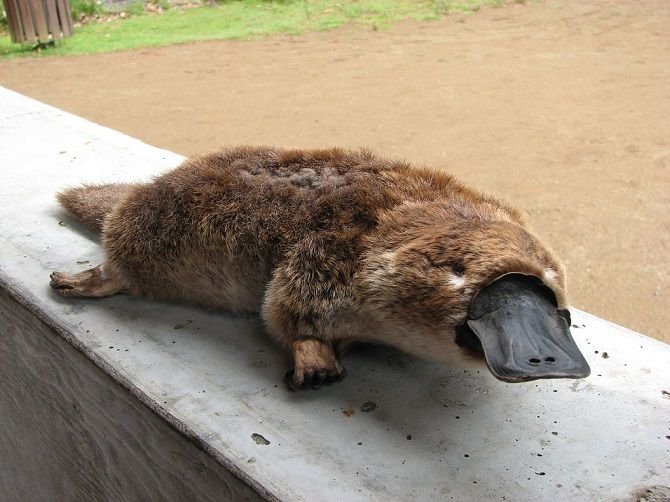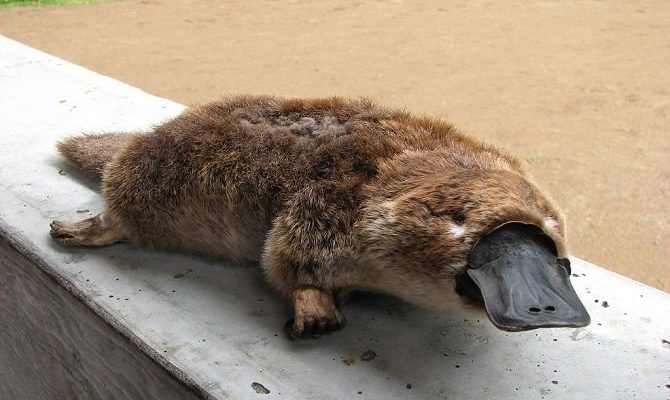
In this piece, we’ll explore ten animals that bear a resemblance to the platypus in one way or another. We’ll break down what makes each of these creatures unique and highlight the differences, helping you tell them apart. Think of it like a zoo visit without the need for a ticket—just you, your curiosity, and a guide through the wild.
1. The Echidna
Let’s start with the echidna, another Australian native. Like the platypus, echidnas are monotremes, meaning they lay eggs instead of giving birth to live young. You might recognize an echidna by its spiky coat and elongated snout, which is perfect for digging up ants and termites.
But here’s the thing: while the platypus has a flat bill, the echidna has a long, narrow snout. This snout is designed for tapping into insect nests rather than sifting through mud like the platypus does. Echidnas are also quite shy, often curling into a ball when threatened, whereas the platypus prefers to slip away quietly into the water.
Key Differences
- Habitat: Echidnas are primarily terrestrial, while platypuses are aquatic.
- Body Covering: Echidnas have spines, while platypuses are covered in dense fur.
2. The North American Beaver
Next up is the beaver, a well-known rodent famous for its dam-building skills. Beavers have flat tails and webbed feet—traits they use for an aquatic lifestyle. They spend a lot of time in the water, similar to the platypus, which can make it easy to mistake one for the other at a glance.
However, beavers are much larger than platypuses and lack that peculiar duck bill. While both animals build structures in or near water, beavers focus on creating dams with logs and mud, while platypuses dig burrows to nest in.
Key Differences
- Size: Beavers can weigh up to 60 pounds, whereas platypuses are usually around 5 pounds.
- Diet: Beavers are herbivores, eating bark and aquatic plants; platypuses are carnivorous, feeding on insects and crustaceans.
3. The Nutria
Also known as coypu, nutria are large semi-aquatic rodents that resemble beavers in their webbed feet and love for water. They have a somewhat similar body shape, but again, there are many differences. Nutria have long, rat-like tails and are known for their orange front teeth—totally different from the platypus’s bill.
Nutria are often seen foraging along riverbanks and marshes. While platypuses stay hidden beneath the water’s surface, nutria stick to the edges, making them easier to spot in the wild.
Key Differences
- Tails: Nutria have long, scaly tails, while the platypus has a flat, paddle-like one.
- Appearance: Nutria are covered in fur, whereas platypuses have fur as well but with a more streamlined body.
4. The Otter
Otters are playful little critters often seen frolicking in water. They have streamlined bodies and webbed feet, making them excellent swimmers like the platypus. While platypuses rely on their sensitive bills, otters use their keen eyesight and whiskers to hunt for fish and crustaceans.
You might notice that otters are much more social creatures. They often live in groups, playing and hunting together, while the platypus tends to be a solitary animal that prefers quiet waters.
Key Differences
- Social Behavior: Otters are social and live in groups, while platypuses are solitary.
- Diet: Otters primarily eat fish, while platypuses have a more varied diet that includes insects.
5. The Aye-Aye
Now, let’s take a trip to Madagascar to meet the aye-aye. This unusual primate has a distinct appearance with its long fingers and bushy tail. While it doesn’t have any physical resemblance to the platypus, it shares a similar quirky vibe. Like the platypus, the aye-aye is also a nocturnal forager that uses unique adaptations for feeding.
Aye-ayes have a special elongated middle finger that helps them tap on trees to find larvae, much like how a platypus uses its bill to detect prey in the water. Despite their differences in habitat and appearance, they both showcase the wonders of adaptation in the animal kingdom.
Key Differences
- Habitat: Aye-ayes live in trees, whereas platypuses are aquatic dwellers.
- Feeding Adaptation: Aye-ayes use their long fingers, while platypuses utilize their bills.
6. The Sea Otter
Sea otters are a marine mammal that’s often confused with the platypus due to their aquatic lifestyle. Sea otters have thick fur and are known for their remarkable ability to use tools, like rocks, to crack open shellfish.
While both animals look adorable while swimming, sea otters tend to navigate through kelp forests and have a very different diet, focusing on sea urchins and crabs. Unlike the solitary platypus, sea otters often wrap up in kelp to stay anchored while they sleep.
Key Differences
- Diet: Sea otters primarily consume marine invertebrates, while platypuses eat insects and small crustaceans.
- Behavior: Sea otters are social and often seen in groups, while platypuses prefer solitude.
7. The Capybara
The capybara is the world’s largest rodent, and it has a laid-back style that you might liken to the platypus. They are excellent swimmers, often found lounging by rivers and lakes. Capybaras are social creatures that prefer to hang out in groups, unlike the solitary platypus.
While they both enjoy water, capybaras have a more robust body and a rounded face, making them quite distinct. Plus, they graze on grasses and water plants, differing from the insect-eating habits of platypuses.
Key Differences
- Size: Capybaras can weigh over 100 pounds, while platypuses are much smaller.
- Social Structure: Capybaras are very social, often living in large groups.
8. The Fennec Fox
You might wonder why a fennec fox is on this list, given that it’s a desert dweller with large ears and a fluffy tail. But hear me out! The fennec fox is another example of unique adaptation. While the platypus has developed a variety of features for aquatic life, the fennec fox has impacted desert survival, relying on its keen senses to find food and avoid predators in a harsher environment.
Both animals showcase how different habitats result in distinct adaptations. Where one thrives in water, the other does so in the dry heat of the Sahara.
Key Differences
- Habitat: Fennec foxes live in deserts, while platypuses thrive in aquatic environments.
- Adaptations: Fennec foxes have large ears for cooling down and keen hearing; platypuses have a bill for detecting prey underwater.
9. The River Dolphin
River dolphins, like the Amazon river dolphin, are often found in freshwater rivers and can sometimes be mistaken for platypuses due to their unique behaviors in the water. Both are adapted for life in aquatic environments, but river dolphins are fully mammalian.
These dolphins have a distinct pink hue and can grow to be quite large. Their diet consists mainly of fish, and they play an important role in their ecosystems. In contrast, platypuses are much smaller and specialize in insects and crustaceans.
Key Differences
- Size: River dolphins are significantly larger than platypuses.
- Diet: River dolphins primarily eat fish, while platypuses hunt insects.
10. The Beavertail Catfish
Last but not least, we have the beavertail catfish, a freshwater fish that shares a name with the beaver due to its flat, paddle-like tail. Although they might resemble platypuses in tail structure, their overall appearance is quite different. Catfish have whisker-like barbels around their mouths, which they use to sense food in murky waters, showcasing another unique adaptation for survival.
While you might think they share a habitat preference, platypuses are mammals, and these catfish belong to a different classification altogether. It’s fascinating how nature can create such variety!
Key Differences
- Classification: Beaver catfish are fish, while platypuses are mammals.
- Adaptation: Catfish have barbels for sensing food, while platypuses have bills.
In closing, the animal kingdom is filled with fascinating creatures that share similarities, yet each has its unique traits and adaptations. From the monotreme relatives like echidnas to playful otters and massive capybaras, understanding how these animals relate to the platypus enriches our appreciation for biodiversity. Next time you encounter a platypus or any of these interesting animals, you’ll have a whole new perspective on their quirks and charm!

